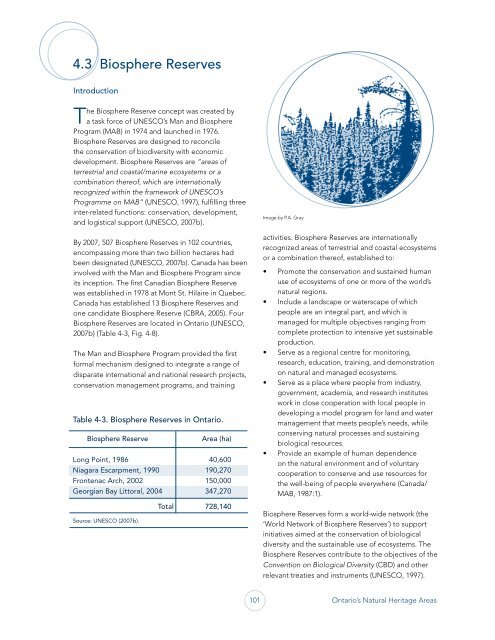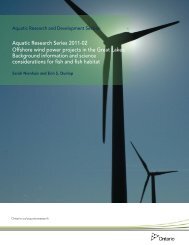Ontario's Natural Heritage Areas - Ministry of Natural Resources
Ontario's Natural Heritage Areas - Ministry of Natural Resources
Ontario's Natural Heritage Areas - Ministry of Natural Resources
You also want an ePaper? Increase the reach of your titles
YUMPU automatically turns print PDFs into web optimized ePapers that Google loves.
4.3 Biosphere Reserves<br />
Introduction<br />
The Biosphere Reserve concept was created by<br />
a task force <strong>of</strong> UNESCO’s Man and Biosphere<br />
Program (MAB) in 1974 and launched in 1976.<br />
Biosphere Reserves are designed to reconcile<br />
the conservation <strong>of</strong> biodiversity with economic<br />
development. Biosphere Reserves are “areas <strong>of</strong><br />
terrestrial and coastal/marine ecosystems or a<br />
combination there<strong>of</strong>, which are internationally<br />
recognized within the framework <strong>of</strong> UNESCO’s<br />
Programme on MAB” (UNESCO, 1997), fulfilling three<br />
inter-related functions: conservation, development,<br />
and logistical support (UNESCO, 2007b).<br />
By 2007, 507 Biosphere Reserves in 102 countries,<br />
encompassing more than two billion hectares had<br />
been designated (UNESCO, 2007b). Canada has been<br />
involved with the Man and Biosphere Program since<br />
its inception. The first Canadian Biosphere Reserve<br />
was established in 1978 at Mont St. Hilaire in Quebec.<br />
Canada has established 13 Biosphere Reserves and<br />
one candidate Biosphere Reserve (CBRA, 2005). Four<br />
Biosphere Reserves are located in Ontario (UNESCO,<br />
2007b) (Table 4-3, Fig. 4-8).<br />
The Man and Biosphere Program provided the first<br />
formal mechanism designed to integrate a range <strong>of</strong><br />
disparate international and national research projects,<br />
conservation management programs, and training<br />
Table 4-3. Biosphere Reserves in Ontario.<br />
Biosphere Reserve Area (ha)<br />
Long Point, 1986 40,600<br />
Niagara Escarpment, 1990 190,270<br />
Frontenac Arch, 2002 150,000<br />
Georgian Bay Littoral, 2004 347,270<br />
Source: UNESCO (2007b).<br />
Total 728,140<br />
Image by P.A. Gray<br />
activities. Biosphere Reserves are internationally<br />
recognized areas <strong>of</strong> terrestrial and coastal ecosystems<br />
or a combination there<strong>of</strong>, established to:<br />
• Promote the conservation and sustained human<br />
use <strong>of</strong> ecosystems <strong>of</strong> one or more <strong>of</strong> the world’s<br />
natural regions.<br />
• Include a landscape or waterscape <strong>of</strong> which<br />
people are an integral part, and which is<br />
managed for multiple objectives ranging from<br />
complete protection to intensive yet sustainable<br />
production.<br />
• Serve as a regional centre for monitoring,<br />
research, education, training, and demonstration<br />
on natural and managed ecosystems.<br />
• Serve as a place where people from industry,<br />
government, academia, and research institutes<br />
work in close cooperation with local people in<br />
developing a model program for land and water<br />
management that meets people’s needs, while<br />
conserving natural processes and sustaining<br />
biological resources.<br />
• Provide an example <strong>of</strong> human dependence<br />
on the natural environment and <strong>of</strong> voluntary<br />
cooperation to conserve and use resources for<br />
the well-being <strong>of</strong> people everywhere (Canada/<br />
MAB, 1987:1).<br />
Biosphere Reserves form a world-wide network (the<br />
‘World Network <strong>of</strong> Biosphere Reserves’) to support<br />
initiatives aimed at the conservation <strong>of</strong> biological<br />
diversity and the sustainable use <strong>of</strong> ecosystems. The<br />
Biosphere Reserves contribute to the objectives <strong>of</strong> the<br />
Convention on Biological Diversity (CBD) and other<br />
relevant treaties and instruments (UNESCO, 1997).<br />
101 Ontario’s <strong>Natural</strong> <strong>Heritage</strong> <strong>Areas</strong>

















